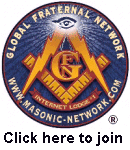
The GFN Treasure Chest Archives
www.masonic-network.com
"Where Master Masons Communicate"

 |
The GFN Treasure Chest Archiveswww.masonic-network.com |
 |
In Peking, in China, there is a place called the temple of Heaven, one of the few ancient relics of the Chinese monotheistic faith. It is constructed in the form of a square, with special seats in the east, the west and the south. There is an altar in the very centre. There are three circular platforms of diameters of 90 feet, 150 feet, and 210 feet. Note that these are in the ratio of 3, 5 and 7. The temple was built in 1420, but the altar is considered to be 4000 years old. There was a society called HUNG, or "The Brotherhood of Heaven and earth". This can be traced back to 386 AD. It had a supreme Grand Master, a Senior and Junior Warden, and many subordinate lodges. In the lodge ceremonies, the initiate knelt at the altar, with the Senior and Junior Wardens kneeling at his right and left, each holding a sword overhead to form a right angle over the candidate. The lecture given by the Worshipful Master taught that all are equal, that they must live uprightly and justly, that they must help a brother in distress, preserve his secrets, respect the chastity of his wife, and that they must obey the Worshipful Master.
The three great principles of the Hung lodge were Brotherly Love, Relief and Truth. Brethren, it is interesting to note that there has been no Masonry on mainland China for very many years, but now, in 1988, a new Lodge is being constituted there under the Irish Constitution.
Ref: Lodge of Research No.200 (1993), Grand Lodge of Ireland, and Ashlar Lodge No.247, G.R.C. (May 1993)
Editor: While definite historical evidence for the Hung may not go back beyond 1662, Hwui-yin did establish his "White Lotus Society", at Rozan, south of the Yang Tze, c.376 AD. Due to persecutions of worshippers of Amitabha Buddha, the White Lotus went through a quiescent period until Han Shan-tung (1344) revitalised the Society. By the 18th century the Hung and the White Lotus are intermingled until primarily the Hung are only heard of. The White Lotus did rise up after the slaying of Su Hung-u-, and the in the proclamation of 1662.